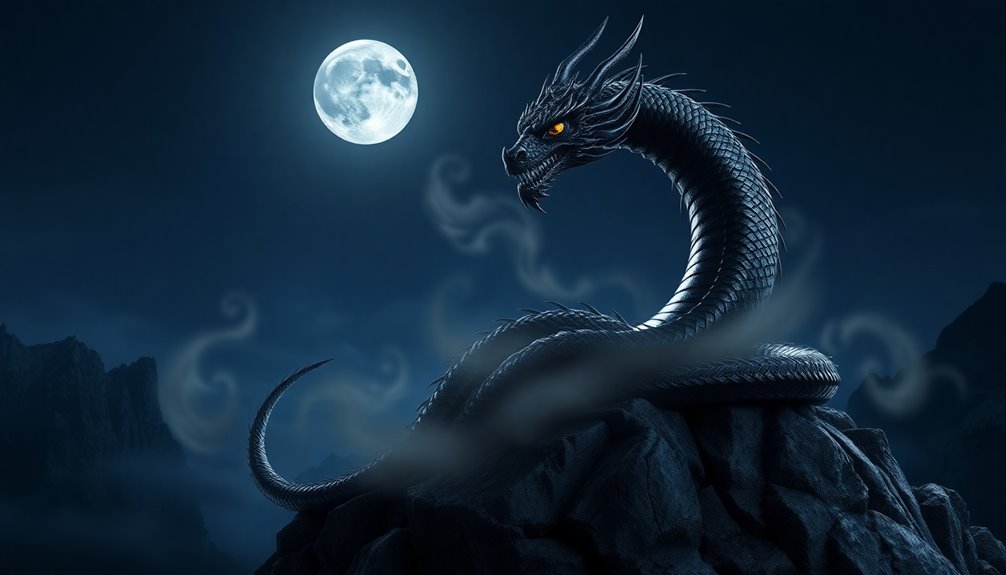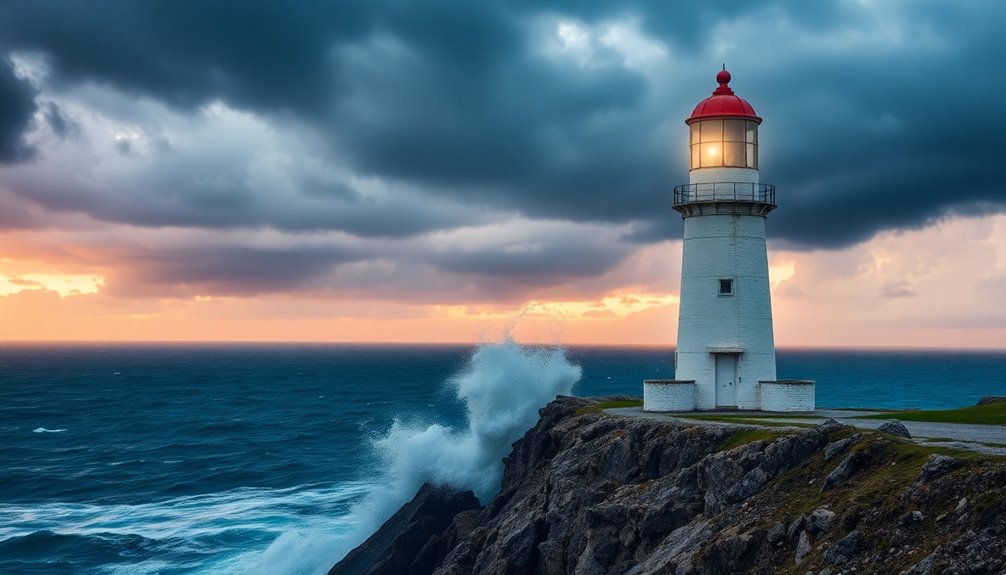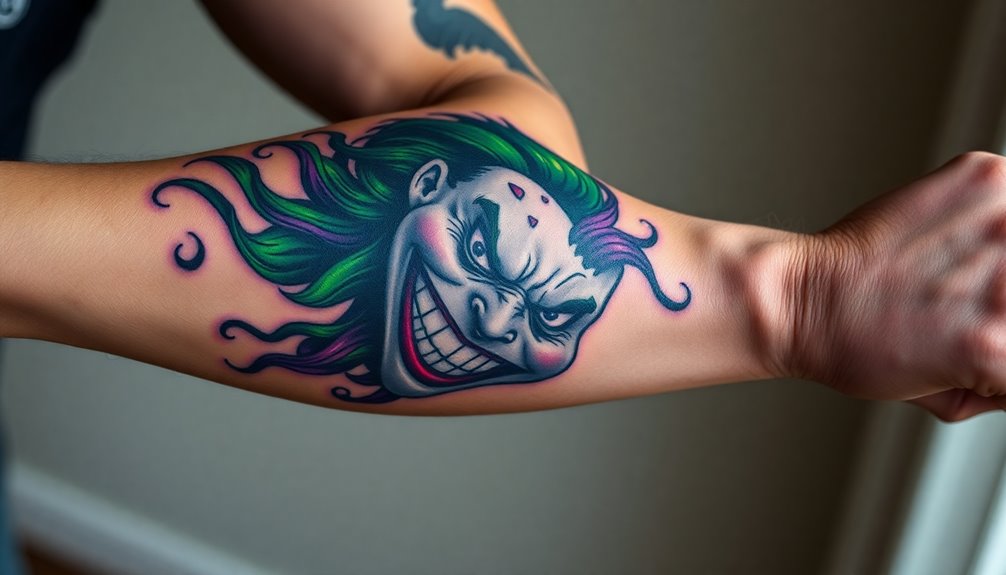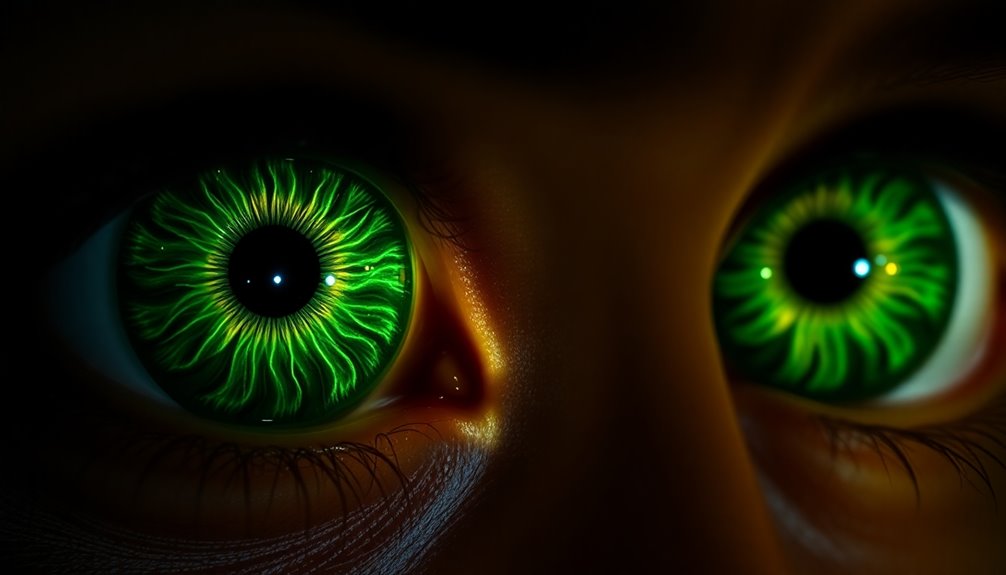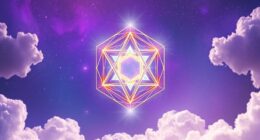The black dragon stands as a potent symbol of power and mystery across cultures. In Chinese tradition, it represents strength and good fortune, serving as a protector while governing rain and abundance. You might also find it portrayed with dual meanings, embodying both creation and destruction. In martial arts, it symbolizes inner growth and resilience, honoring the spirit of ancient practices. Celebrated in festivals, it connects communities and invites blessings, showcasing its cultural significance. If you explore further, you'll uncover more fascinating insights into the black dragon's diverse representations and its enduring impact on modern culture.
Key Takeaways
- Black dragons symbolize wisdom, strength, and power, representing authority and mastery across various cultures.
- In Chinese mythology, black dragons are revered as protectors, embodying good fortune and safeguarding against evil.
- They are associated with water and fertility, acting as bringers of abundance crucial for agricultural success.
- The duality of black dragons reflects the balance between creation and destruction, captivating imaginations with their transformative nature.
- Celebrations like the Dragon Boat Festival honor the black dragon's significance in cultural heritage and community bonding.
Origin and Appearance
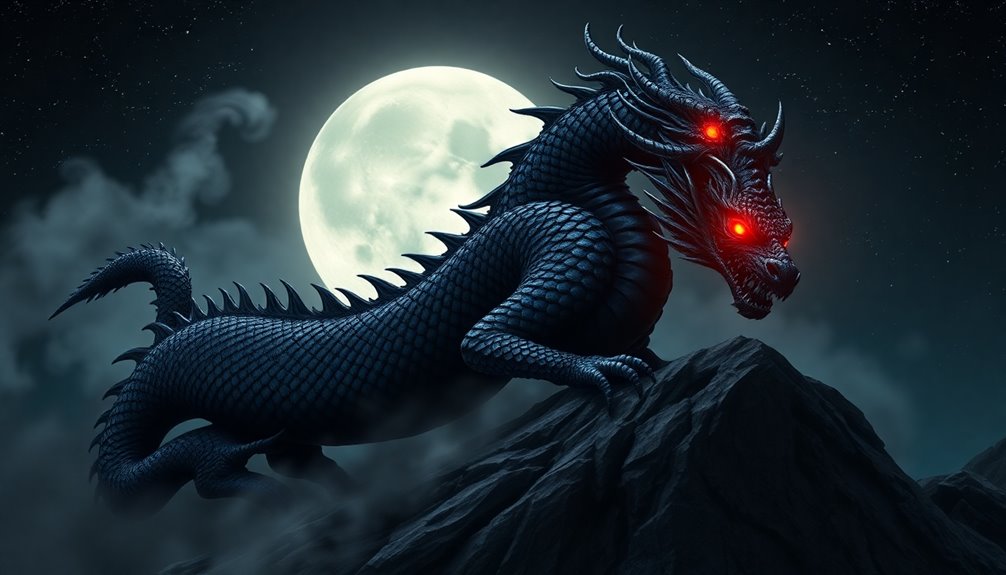
The allure of black dragons lies in their rich mythological origins and striking appearances. These creatures span diverse cultures, from Western Europe, where they embody evil and darkness, to ancient China, where they've been part of totem-worship since at least 3000 BCE. In Western myths, black dragons often breathe fire and are portrayed as menacing, whereas, in Eastern traditions, they symbolize vengeance and wield the powers of the air in Daoism.
Physically, black dragons captivate with their glossy black scales that age into dull, thicker armor. When young, their scales help them blend into marshy environments, while their skeletal features become more pronounced over time, revealing a dramatic transformation. Their skull-like faces, deep eye sockets, and broad nasal openings contribute to their eerie presence. As they mature, their curving, segmented horns darken to black, adding to their imposing figure. The upper neck is adorned with a large frill, enhancing their majestic but fearsome appearance.
With a forked, flat tongue and acidic drool, black dragons leave a lasting impression, making them one of the most enigmatic figures in mythology. Moreover, their association with the unknown reflects their connection to the chaotic elements of life, further deepening their mystique.
Symbolism and Meanings
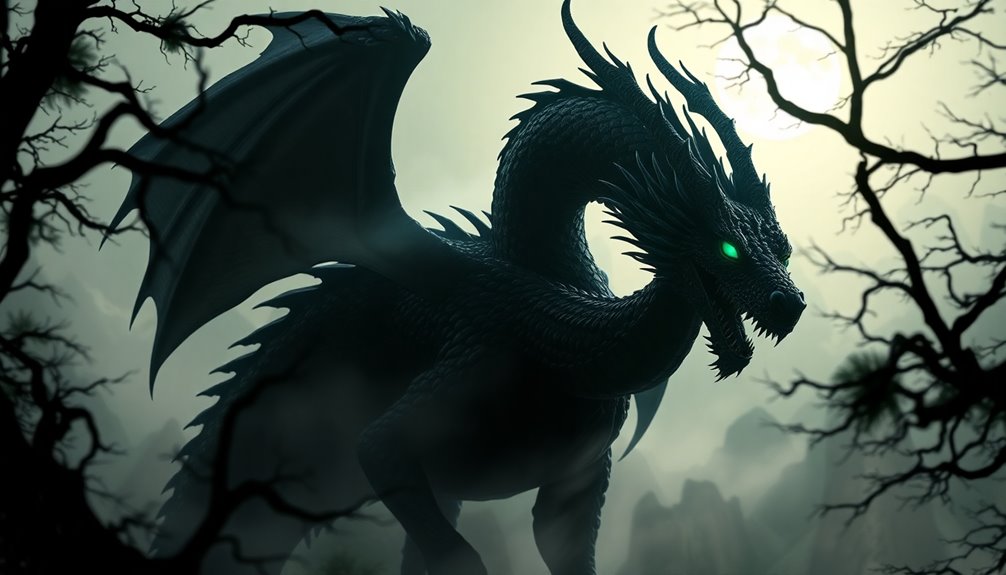
Deeply woven into various cultural narratives, black dragons symbolize a multifaceted array of meanings that resonate across both Eastern and Western traditions. You'll find that they often embody wisdom and power, representing the pinnacle of strength and authority. As rulers of all dragons, they symbolize heavenly wisdom and are associated with the yang energy, embodying both good luck and imperial might.
In addition to their regal attributes, black dragons are closely tied to water and rainfall, which are essential for agriculture. They act as bringers of abundance and fertility, controlling natural elements to ensure bountiful harvests and prosperity. This connection to water reinforces their role as protectors, safeguarding those deemed worthy and defeating evil spirits. The black dragon, known as Xuanlong, is revered as a powerful force within Chinese mythology.
Culturally, black dragons influence various practices, including martial arts and traditional performances like the dragon dance. They symbolize transformation and the cyclical nature of life, embodying the balance between good and bad forces.
Ultimately, they represent a deep reservoir of hidden wisdom, urging you to explore your subconscious for greater understanding and growth.
Role in Chinese Culture
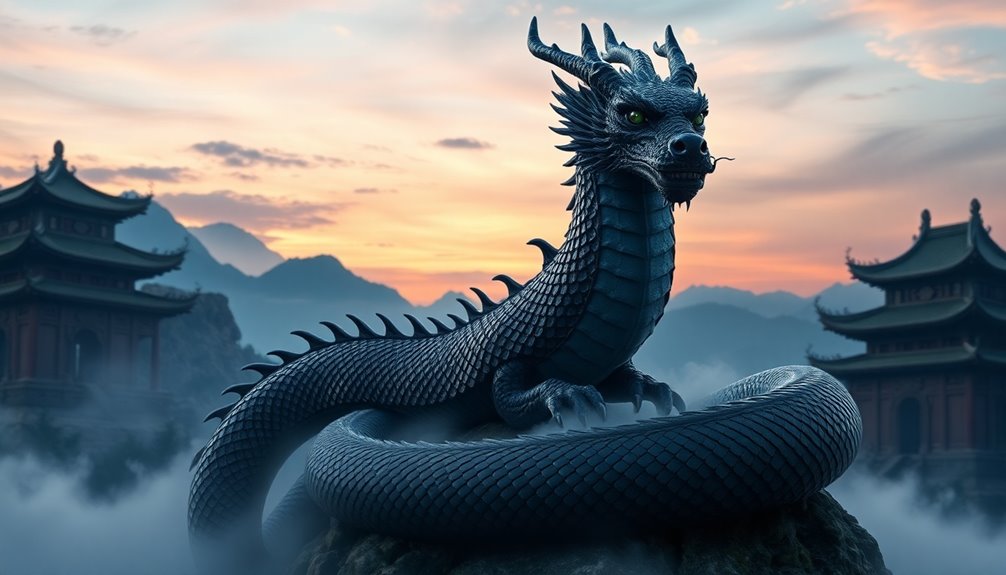
How does the black dragon shape Chinese culture? This powerful creature deeply influences various aspects of Chinese life, from mythology to imperial symbols.
Associated with water and weather, the black dragon governs the North Sea and controls rainfall, embodying good fortune. You'll find it in myths where it manages floods and storms, reflecting its dual nature—both nurturing and destructive. Additionally, it is recognized as the ancestor of the North Sea Dragon King, emphasizing its importance in the pantheon of dragons.
Furthermore, the black dragon symbolizes imperial power and divine authority. Emperors aligned themselves with its protective qualities, using the dragon symbol to assert their semi-divine status. Only the emperor could rightfully bear this emblem, showcasing their connection to divine rule.
In art and performance, the black dragon remains a cultural icon. You can see it in traditional sculptures, paintings, and the lively dragon dance during festivals, which aims to bring good luck and ward off evil spirits.
Its serpentine body and sparkling eyes captivate audiences and reflect its significance in both ancient and modern contexts. The black dragon's essence continues to resonate, influencing everything from folklore to popular culture, ensuring its place in the heart of Chinese heritage.
Representation in Martial Arts
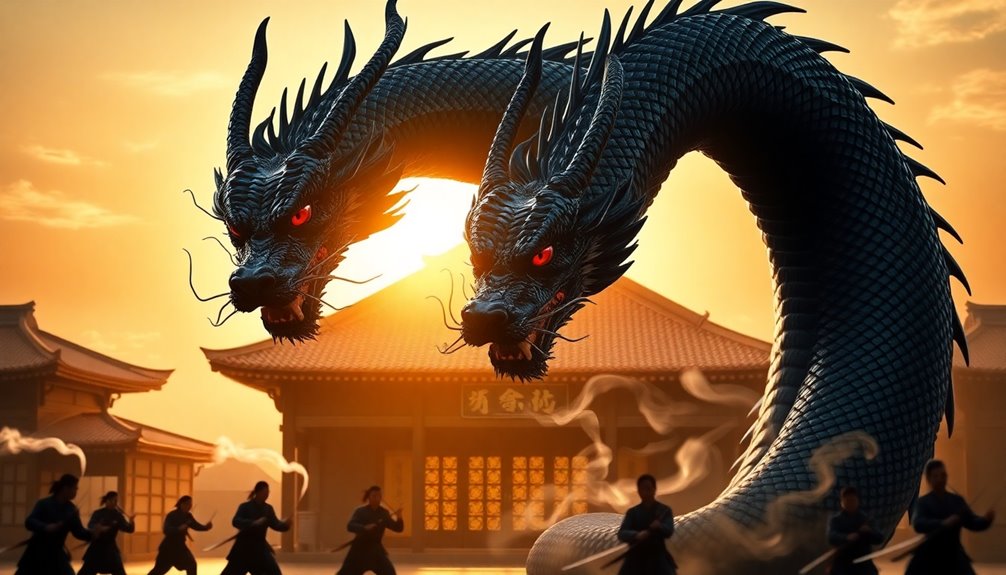
Representing strength and spirit, the black dragon plays a significant role in martial arts, embodying the virtues and philosophies practitioners strive to uphold. Founded by John Keehan in 1969, this style honors the rich history of Kumite fighting, symbolized by a running dragon looking back on itself. Rooted in ancient Chinese martial arts from the Kwangtung temple, it evolved from the Sillum Wu Hok Lung style. The black dragon symbolizes inner spirit, growth, and wisdom. It encourages flexibility and adaptability in combat, emphasizing close-range fighting techniques and the importance of outsmarting opponents. Notably, the legacy of the black dragon is intertwined with the Kumite's secret society known among martial arts masters.
Key figures like Dr. Robert Rapue and Senzo Tanaka shaped its development, while members like Victor Moore and Frank Dux made significant contributions to its legacy, competing against legends like Bruce Lee. This martial art promotes camaraderie and respect, opposing evil inclinations within oneself and others. Engaging in trust-building activities within training fosters a supportive environment that enhances the growth of all practitioners.
Festivals Celebrating the Black Dragon
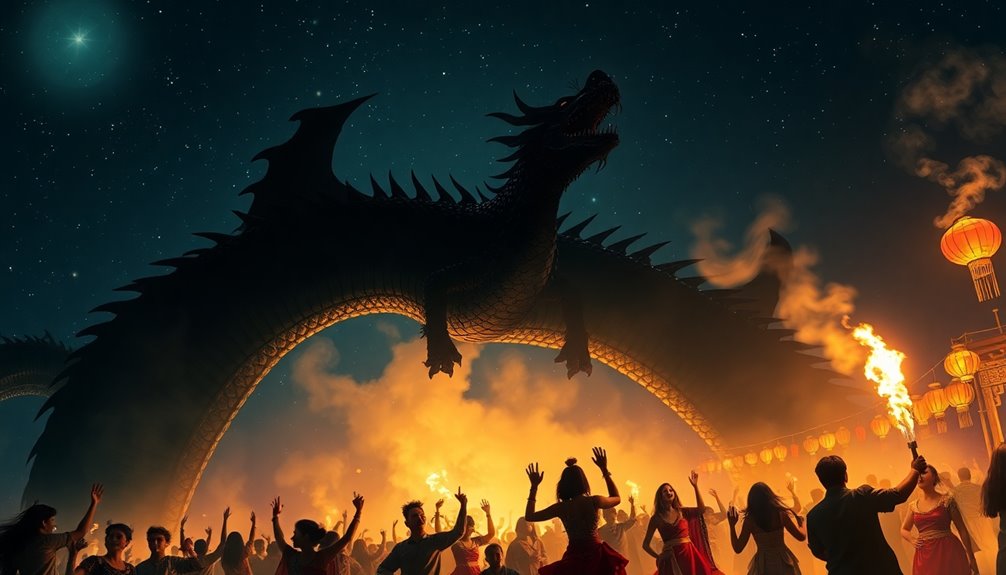
Festivals celebrating the black dragon frequently highlight its cultural significance and connection to prosperity. These vibrant events often center around themes of water, rainfall, and good fortune, which are essential for bountiful harvests. One of the most notable celebrations is the Dragon Boat Festival, where you can witness thrilling dragon boat races that honor this powerful symbol. In fact, the festival is known for its dragon boat racing which attracts thousands of paddlers and spectators in Hong Kong.
During these festivals, dragons are paraded to drive away evil spirits and invite blessings, reflecting the black dragon's protective nature. You'll find that community participation is vital, as locals come together to honor the dragon king through offerings and rituals, strengthening social bonds and cultural heritage.
Additionally, these gatherings take place during seasonal observances when the risk of bad luck is high, showcasing the dragon's role in safeguarding communities. You may see practices like burning joss paper, aimed at pacifying water ghosts while requesting protection and abundance.
Art and Popular Culture
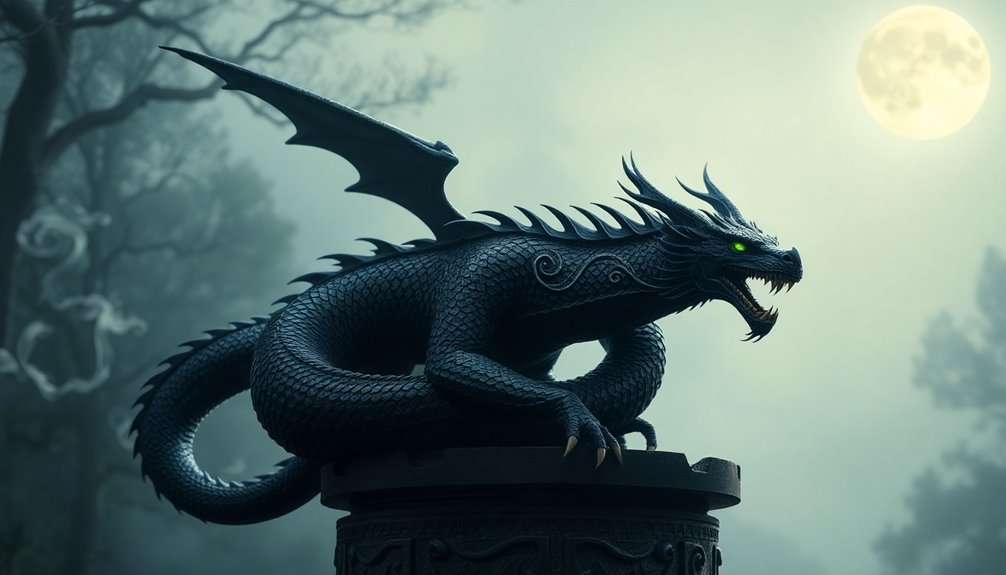
The black dragon has made its mark on art and popular culture, captivating audiences with its majestic and mysterious presence. In traditional Chinese art, you'll find the black dragon depicted with a serpentine body and scaly skin, its eyes sparkling like stars. These representations symbolize power, luck, and fortune, making the black dragon a popular motif in various art forms.
In martial arts, particularly Kung Fu, the black dragon embodies inner strength and discipline, with its graceful movements symbolizing mastery. You can witness its influence in traditional dances like the dragon dance, which signifies good luck and wards off evil spirits.
Modern media continues to celebrate the black dragon's allure, appearing in films, video games, and literature. For instance, in Dungeons & Dragons, the design emphasizes agility and intelligence, drawing inspiration from real-world creatures. The new Black Dragon design highlights dexterity as a key strength, enhancing the creature's menacing and intelligent portrayal. Animation techniques enhance the black dragon's intelligence and villainous aspects, making it even more engaging.
Across cultures, the black dragon represents water and prosperity, contrasting with Western views of evil. Its presence in art and popular culture reflects a deep-rooted significance that resonates with many, showcasing its enduring legacy.
Divergent Interpretations
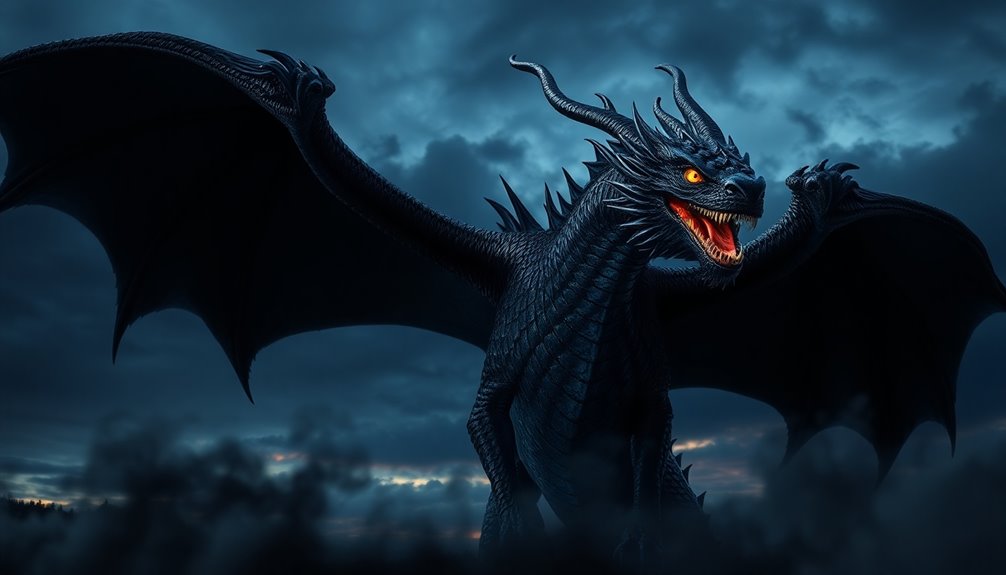
Art and popular culture highlight the complexity of the black dragon, but interpretations of this powerful symbol vary widely across different cultures and contexts.
In Chinese culture, the black dragon embodies water, wisdom, and protection, symbolizing good fortune essential for agriculture. It's revered as a dominant force, representing inner strength in martial arts.
Conversely, in Western interpretations, black dragons often symbolize evil, associated with destructive forces that devour. Ancient Egyptians linked black with resurrection and fertility, while the Apache connected it to the setting sun in the West.
These diverse meanings reveal how the black dragon can embody power and authority, yet also evoke fear and mourning.
In historical contexts, the Black Dragon Society in Japan adopted the symbol for ultra-nationalist agendas, promoting aggressive policies and anti-Western sentiments during World War II. This illustrates how the black dragon can reflect varying ideologies, from mysticism to nationalism. The society's influence contributed to the rise of militarism in Japan during this tumultuous period.
Ultimately, whether viewed as a protector or a harbinger of darkness, the black dragon captivates the imagination, inviting you to explore the depths of its multifaceted nature across cultures.
Black Dragon in Mythology
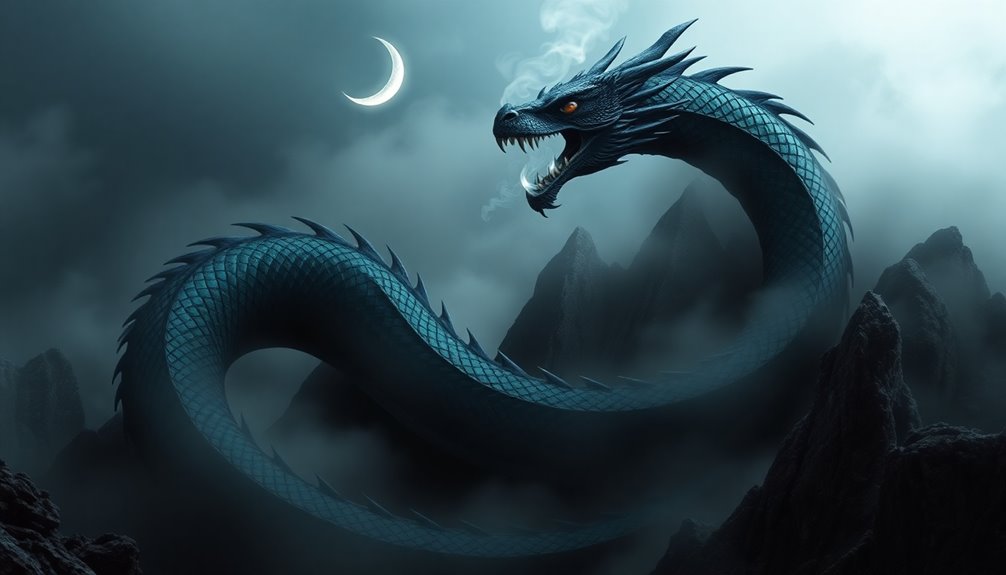
Throughout various mythologies, the black dragon emerges as a captivating and complex figure, embodying both formidable power and deep symbolism.
In Western mythology, you'll find black dragons depicted as cunning and malevolent creatures, often siding with evil forces. Known as "skull dragons," they possess deeply set eye sockets and glossy black scales that grow dull with age. Typically inhabiting marshes and underground caves, their presence is marked by the smell of rotting vegetation and stagnant water. Their ambush tactics further emphasize their cunning nature, as they often use their environment to surprise unsuspecting prey.
Conversely, in Eastern mythology, particularly Chinese, the black dragon (Heilong) is a symbol of power and control over the North Sea. As a general under the Water God Gonggong, Heilong wields great magical abilities and can summon storms and floods during battles against the Fire God Zhurong.
While in Western cultures black dragons represent incarnated evil, their Eastern counterparts are linked to elements like water and fertility, showcasing a duality in their nature.
In both traditions, these dragons embody the balance between creation and destruction, making them powerful figures in the mythology you explore. Their legendary roles highlight their ability to manipulate environments and impact the lives of those around them.
Modern Day Significance
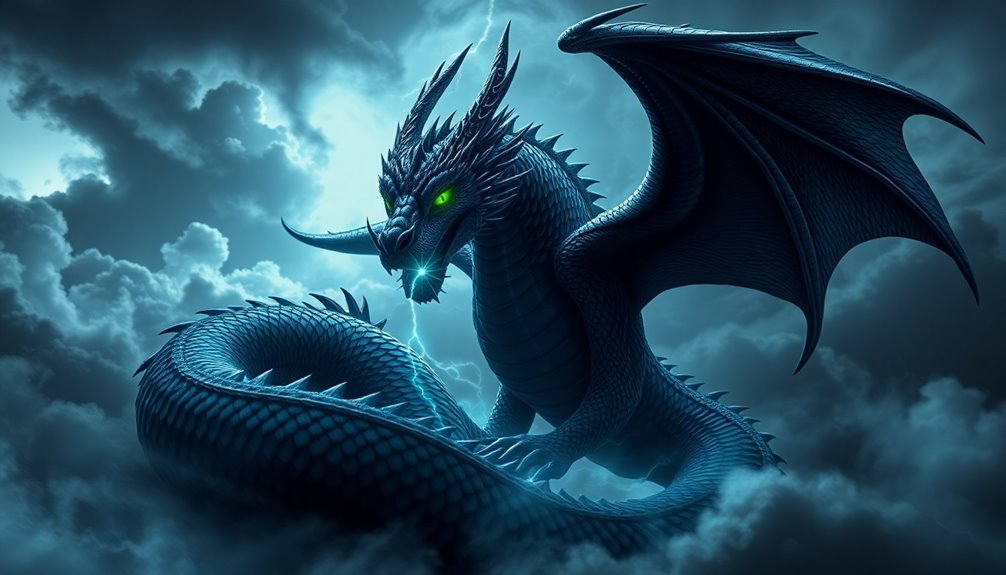
Embodying strength and mystique, the black dragon holds significant modern cultural relevance, particularly in Chinese society. You'll often see it in Chinese martial arts, where it symbolizes inner strength and discipline, especially through various Kung Fu styles. In traditional performances like the dragon dance, it signifies good luck and drives away evil spirits, enhancing community celebrations.
In popular culture, the black dragon captivates audiences in movies, video games, and literature, embodying power and intrigue. It's also a staple in Chinese art, appearing in intricate sculptures and vibrant paintings that represent luck and fortune. The dragon evokes national pride, with many Chinese proudly identifying as "descendants of the dragon." Additionally, the black dragon's symbolism is deeply rooted in China's cultural heritage, representing the harmony between humans and nature and reflecting the importance of Aboriginal cultural identity in fostering a sense of belonging.
Symbolically, the black dragon connects to water and rainfall, signifying abundance and fertility—important in agricultural contexts. It embodies wisdom, strength, and dominance, reflecting values rooted in tradition. Additionally, it serves as a protective symbol, safeguarding the worthy and bestowing prosperity. As a representation of yang energy, it links to imperial authority and symbolizes transformation, renewal, and the cyclical nature of life, influencing both spiritual and philosophical discussions today.
Frequently Asked Questions
What Are the Different Types of Dragons in Chinese Mythology?
In Chinese mythology, you'll find various dragon types, each with unique characteristics. The Blue Dragon controls wind and fire, while the White Tiger represents the west.
The Winged Dragon rules the skies, managing the seasons, and the Coiling Dragon stays on earth, governing time.
Additionally, the Nine Sons of the Dragon showcase distinct traits, like Bixi, who carries heavy objects, and Qiuniu, known for its musical talent.
Each dragon plays a significant role in mythology.
How Does the Black Dragon Differ From Western Dragons?
When you compare the black dragon to Western dragons, you'll notice key differences.
Western black dragons are large, bat-like creatures that dwell in marshes and are known for their cunning, evil nature.
In contrast, Chinese black dragons are snake-like, often associated with water and storms, and embody a more complex symbolism.
While Western dragons symbolize pure evil, Chinese dragons represent vengeance and can be seen as both destructive and protective in various contexts.
What Colors Are Associated With Different Dragon Types in Chinese Culture?
In Chinese culture, different colors symbolize various dragon types.
Blue and green dragons connect with nature and growth, while yellow dragons represent imperial power and wisdom.
Red dragons signify fire, luck, and passion.
Black dragons embody power and storms, whereas white dragons symbolize purity and mourning.
Each color reflects unique traits, influencing your understanding of these mythical creatures.
Are There Specific Rituals for Invoking the Black Dragon's Power?
Yes, there are specific rituals for invoking the black dragon's power.
Start by creating a sacred space adorned with dragon-related items. Light candles and incense to set the mood, then meditate to clear your mind.
Visualize the black dragon's form and energy while chanting an invocation. Request assistance for your specific needs, focusing on areas like protection or healing.
Lastly, perform a guided meditation to connect deeply with the black dragon's energy.
How Has the Black Dragon Influenced Other Cultures Worldwide?
The black dragon has significantly influenced various cultures globally.
In Eastern cultures, it symbolizes wisdom and power, often appearing in art and martial practices.
Conversely, in Western cultures, it's seen as a representation of evil and destruction.
Its presence in modern media, like movies and video games, showcases its mystique.
As you explore these cultural representations, you'll notice the contrasting interpretations and the universal themes of strength and fortune associated with dragons.
Conclusion
In conclusion, the black dragon embodies a rich tapestry of power, mystery, and cultural significance. From its origins and striking appearance to its roles in martial arts and festivals, this mythical creature captivates imaginations. You'll find the black dragon represented across various art forms and interpretations, highlighting its enduring allure. Whether in ancient mythology or modern pop culture, the black dragon remains a symbol that resonates deeply, inviting you to explore its fascinating depths.

